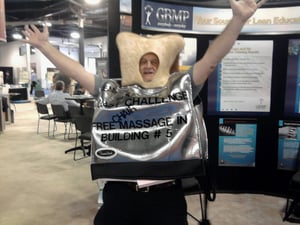In my last post I made the case for regular practice (everybody everyday) of new perspectives, behaviors and practices. All new learners begin by just “going through the motions” and gradually become proficient through regular practice. I’ve personally gone to sleep many nights pondering a new concept or thinking about a new skill only to awaken the next morning with greater understanding. It seems as though our brains actively reflect on the day’s experiences while we sleep. Each day of practice that we miss is therefore a day void of that particular learning. It’s time lost that cannot be made up by cramming. I’m not offering proof here, only my own repeated experience.
In the case of my seven-year-old son’s guitar lessons, I reminded him of this: “Practice makes perfect.”
In the case of Lean learning, however, the challenge is much greater. Students are almost always already “practiced”, but at the wrong things. A friend of mine who manages several US and Mexican lean implementations commented, “The Mexican employees are much more receptive to Lean thinking because many have never worked in a factory before, and have no idea that there is a non-Lean way of producing.”
American workers and managers already have a well-established mental model of how a plant should run. They practice according to that non-Lean model every workday. Roles, rules, and routines are played out according to a status quo game book. Ryuji Fukuda likens this vicious circle to a golfer with a bad golf swing going to the links every day to “perfect” his incorrect form. Practice does not really make perfect in that case – but it does make it permanent!
Then we tap those employees for a “kaizen event.” Even from an optimistic view point, employees who participate in events, only get to “sleep on” a few days of the new concepts. For the rest of the month, it’s back to business as usual. They sleep on that. Indeed, one of the arguments for event type kaizen is that it enables suspension of status quo practices for a period of time in order to enable employees to experience a new way. But too often employees only get to “go through the motions”, not to really learn by doing.
“Come Monday,” one production employee related to me at an event I attended, “we’ll be back to where we were.” Unfortunately if post-event homework is not completed, things may be worse on Monday. Employees in the “kaizened” area are left to pick up the pieces. The tacit learning from this process? SOS. Employees sleep on that outcome as well. Some years ago I signed a contract with a manufacturer stipulating that I never utter the word “Kaizen” in the presence of employees, it so enraged them.
Still I regularly visit companies that gauge their success on the numbers of kaizen events. Next to 5S Scores (a topic for another post), “number of kaizen events” is perhaps the most prevalent corporate Lean KPI. However, the majority of these event-counters cannot say that they have reduced inventories or shortened lead-times or improved deliveries or profits beyond a one-time gain. They talk about the difficulty of “sustainment” and wonder aloud why it’s so hard to enculturate employees. The truth is when everybody practices status quo behavior almost everyday, that is what is sustained. If employees are not practicing the new way everyday, by default they are practicing the old. Practice makes permanent.
O.L.D.
 BTW For those you close to Springfield, Massachusetts, don’t miss EASTEC , May 17-18. I’ll be there and hope to see you.
BTW For those you close to Springfield, Massachusetts, don’t miss EASTEC , May 17-18. I’ll be there and hope to see you.

